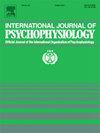Does it always work? Temporal stability of psychological and physiological responses evoked by slow stroking
IF 2.6
3区 心理学
Q3 NEUROSCIENCES
引用次数: 0
Abstract
Slow gentle stroking of the hairy skin, also called affective touch, has both psychological (i.e., pleasantness of the sensation, improvement of mood state) and physiological (e.g., decrease in heart rate) effects. These effects show considerable individual differences; temporal stability of the individual responses is implicitly assumed in the literature but it has never been empirically investigated. 57 young individuals participated in a preregistered study that assessed experiential and physiological effects of slow (3 cm/s) and fast (30 cm/s) stroking delivered on their forearms two times (eight weeks apart). Pleasantness of the skin sensation showed considerable temporal stability (r = 0.73, p < .001), whereas improvement of mood state was less stable over time (r = 0.53, p < .001). Actual (heart rate, skin conductance level, respiratory rate, skin temperature) and perceived (heart rate, respiratory rate, skin temperature) physiological responses to slow stroking were characterized only by moderate stability. Finally, a considerable discordance between actual responses and their perceived counterparts was found. In conclusion, pleasantness of slow stroking can be considered a trait-like characteristic; changes in mood state and physiological responses are less stable, i.e., they might be substantially impacted by situational factors.
它总是有效吗?慢触诱发的心理和生理反应的时间稳定性。
缓慢温柔地抚摸毛茸茸的皮肤,也称为情感触摸,具有心理(即感觉愉悦,情绪状态改善)和生理(例如,降低心率)效果。这些影响显示出相当大的个体差异;在文献中,个体反应的时间稳定性是隐含的假设,但从未进行过实证研究。57名年轻人参加了一项预先登记的研究,该研究评估了前臂慢速(3 厘米/秒)和快速(30 厘米/秒)两次(间隔8周)抚摸的体验和生理影响。皮肤感觉的愉悦表现出相当大的时间稳定性(r = 0.73,p
本文章由计算机程序翻译,如有差异,请以英文原文为准。
求助全文
约1分钟内获得全文
求助全文
来源期刊
CiteScore
5.40
自引率
10.00%
发文量
177
审稿时长
3-8 weeks
期刊介绍:
The International Journal of Psychophysiology is the official journal of the International Organization of Psychophysiology, and provides a respected forum for the publication of high quality original contributions on all aspects of psychophysiology. The journal is interdisciplinary and aims to integrate the neurosciences and behavioral sciences. Empirical, theoretical, and review articles are encouraged in the following areas:
• Cerebral psychophysiology: including functional brain mapping and neuroimaging with Event-Related Potentials (ERPs), Positron Emission Tomography (PET), Functional Magnetic Resonance Imaging (fMRI) and Electroencephalographic studies.
• Autonomic functions: including bilateral electrodermal activity, pupillometry and blood volume changes.
• Cardiovascular Psychophysiology:including studies of blood pressure, cardiac functioning and respiration.
• Somatic psychophysiology: including muscle activity, eye movements and eye blinks.

 求助内容:
求助内容: 应助结果提醒方式:
应助结果提醒方式:


